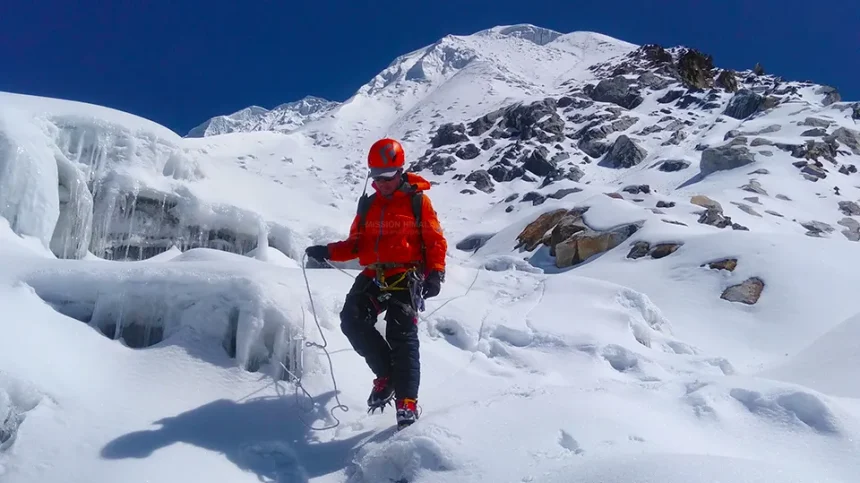Facing the Challenge: Navigating Island Peak’s Glacier and Ice Wall Safely
Climbing Island Peak is a special adventure many people dream about. One of the hardest parts is walking on the Island Peak glacier and climbing the Island Peak ice wall. These parts need careful steps and good safety because they are tricky and can be dangerous if you do not prepare well.
The Island Peak glacier is a big field of ice and snow. It looks beautiful but can be slippery and full of cracks called crevasses. Walking on the glacier means you must wear special shoes called crampons. Crampons help you keep your grip on the ice. Most climbers use ropes and walk with guides who know the glacier well. This helps keep everyone safe.
When you get closer to the summit, you will see the Island Peak ice wall. This wall is a steep, icy slope about 15 to 20 meters high. Climbing this ice wall is a big challenge for many trekkers. To climb it, you need to use ice axes and crampons. The ice wall is not easy, but it feels very rewarding to reach the top after climbing it carefully.
On the ice wall, there are Island Peak ladders fixed to help climbers go up. These ladders make the climb safer and easier. The ladders are strong but narrow. You have to be careful when crossing because the ice below can be very deep. This is called the Island Peak ladder crossing. Climbers usually cross one by one, and guides help to make sure everyone is steady and safe.
Before the climb, it is very important to learn how to use the equipment like crampons, ice axes, and harnesses. Many teams do practice sessions at base camp. These training sessions teach you how to climb the glacier, walk with crampons, and use the ladder for the ice wall. Good training helps reduce fear and makes the climb more successful.
The weather on the glacier and ice wall can change quickly. Sometimes the sun shines, but other times strong winds and snow can make the climb harder. It is important to wear warm clothes in layers and always listen to your guide’s advice about safety and timing. Sometimes climbers must wait for better weather before trying the ice wall.
The feeling of standing on top of Island Peak after crossing the glacier and climbing the ice wall is amazing. You can see many mountains around you and feel proud of yourself. But the climb is not just about reaching the top. It is about respecting the mountain, understanding its dangers, and working with your team.
In summary, the Island Peak glacier and Island Peak ice wall are important parts of the climb that need careful planning and good equipment. The Island Peak ladders and safe Island Peak ladder crossing help climbers finish the hardest parts safely. If you want to try this climb, prepare well and follow your guide’s instructions. This will help you enjoy the adventure and come back safely with great memories.
Step by Step: Techniques to Master Island Peak’s Toughest Climbs
Climbing Island Peak is a great adventure that many people want to try. The climb has some hard parts like the Island Peak glacier and the steep Island Peak ice wall. To finish these parts safely, you need to know the right steps and techniques. This guide will help you learn how to master the toughest climbs on Island Peak step by step.
First, when you start walking on the Island Peak glacier, you need to move carefully. The glacier is made of ice and snow, so it can be very slippery. Wearing crampons on your boots is very important. Crampons help your feet hold on to the ice so you don’t slip. Also, it is good to use a walking stick or ice axe for extra balance. When walking on the glacier, take small steps and watch your foot placement. Always stay close to your team and use ropes if your guide says so. This keeps everyone safe from falling into cracks called crevasses.
Next, you will reach the Island Peak ice wall. This part is very steep and needs special skills to climb. The ice wall is about 15 to 20 meters tall. To climb it, you use ice axes and crampons. You hold the ice axes firmly and kick your crampons into the ice to get a good grip. Then you pull yourself up slowly. It is important to move one hand and one foot at a time so you stay balanced and don’t get tired fast. Climbing the ice wall takes patience and focus.
On the ice wall, you will see the Island Peak ladders. These ladders help climbers get over dangerous ice and crevasses. The ladders are fixed firmly, but are narrow and can feel scary to cross. When you do the Island Peak ladder crossing, always keep your body steady and move slowly. Hold the ladder rails tightly and put your feet carefully on each rung. Crossing the ladder one by one is the safest way, so wait for your turn and watch how your guide crosses.
Before you try these difficult parts, it is very helpful to practice using crampons, ice axes, and climbing with ropes. Many teams do training at base camp or before the climb. These practice sessions teach you the right way to walk on the glacier, climb the ice wall, and cross the ladders safely. Good training gives you confidence and helps you enjoy the climb more.
Remember, the weather on Island Peak can change fast. Sometimes it is sunny, but other times, snow and wind can make climbing harder. Always wear warm clothes in layers and listen to your guide about when it is safe to climb. Sometimes you might have to wait for better weather before going up the ice wall.
In short, mastering the Island Peak glacier and Island Peak ice wall is all about using the right techniques step by step. Wearing crampons, using ice axes well, and moving carefully during the Island Peak ladder crossing are very important. With practice and patience, you can climb Island Peak safely and enjoy the amazing views from the top.
From Base to Summit: Overcoming the Technical Ice Sections of Island Peak
Climbing Island Peak is an exciting journey that takes you from the base camp all the way to the summit. Along the way, you will face some tough sections like the Island Peak glacier and the steep Island Peak ice wall. These parts need special skills and care. This guide will explain how to overcome these technical ice sections from base to summit.
At the start, you arrive at the base camp. This is where you get ready for the climb ahead. You will practice using the tools you need, like crampons and ice axes. The guides teach you how to walk on ice and how to stay safe. Learning these skills is very important because the climb will get harder.
After leaving base camp, you will reach the Island Peak glacier. This glacier is a large area of ice that can be slippery and has deep cracks called crevasses. Walking on the glacier means you have to be careful with each step. You wear crampons to keep your feet from slipping. Using an ice axe or walking stick helps with balance. The guides often tie climbers together with ropes for extra safety on the glacier. Moving slowly and watching your steps is the best way to stay safe here.
Once you finish crossing the glacier, the next big challenge is the Island Peak ice wall. This ice wall is very steep and requires you to climb carefully using ice axes and crampons. The wall is about 15 to 20 meters high. You use your ice axes to hold yourself and your crampons to kick into the ice for good grip. Climbing the ice wall takes patience and strength. It is important to move one hand and one foot at a time to keep balance.
On the ice wall, there are Island Peak ladders to help you cross dangerous icy gaps. These ladders are fixed firmly to the ice, but they can be narrow and scary to cross. When you do the Island Peak ladder crossing, move slowly and hold on tight to the rails. Put your feet carefully on each rung. Climbers cross one by one to stay safe. Your guide will help you and ensure that everyone crosses safely.
The weather on Island Peak can change very fast. Sometimes the sun shines brightly, but sometimes snow and wind make climbing harder. It is important to wear warm clothes and be ready to wait for good weather before trying the ice wall or crossing the ladders. Listening to your guide’s advice will help you stay safe.
Reaching the summit after crossing the Island Peak glacier and climbing the Island Peak ice wall feels very special. The views are amazing, and you feel proud of your hard work. But remember, the climb is not just about the top. It is about learning new skills, working with your team, and respecting the mountain.
In conclusion, climbing from base camp to the summit means carefully crossing the Island Peak glacier and the Island Peak ice wall. Using the Island Peak ladders and doing the Island Peak ladder crossing safely are important parts of the journey. With good training, careful steps, and the help of your guides, you can enjoy this wonderful climb and make memories that last a lifetime.
Conclusion
Climbing Island Peak is a special adventure that many people enjoy. Walking on the Island Peak glacier means you must be careful because the ice is slippery and there are deep cracks. Wearing crampons and using an ice axe help you stay safe and balanced. The guides often tie climbers together with ropes for extra safety on the glacier.
The Island Peak ice wall is a steep part that you must climb with ice axes and crampons. It takes patience and good technique. Moving one hand and one foot at a time helps keep balance. The ice wall is not easy, but reaching the top feels very good.
To cross dangerous icy gaps, climbers use the Island Peak ladders. These ladders are strong but narrow. During the Island Peak ladder crossing, it is important to move slowly and hold the ladder rails tightly. Climbers cross one at a time, with guides helping to keep everyone safe.
Weather can change quickly on Island Peak. Sometimes it is warm, and sometimes cold and windy. Wearing warm clothes and listening to your guide are very important for safety. Waiting for good weather before trying the hard parts can make the climb safer.
In the end, climbing Island Peak is about being careful and using the right skills on the Island Peak glacier, the Island Peak ice wall, and using the ladders. With good preparation and the help of guides, you can enjoy this amazing adventure and feel proud of what you have done. The mountain teaches patience, teamwork, and respect for nature.











